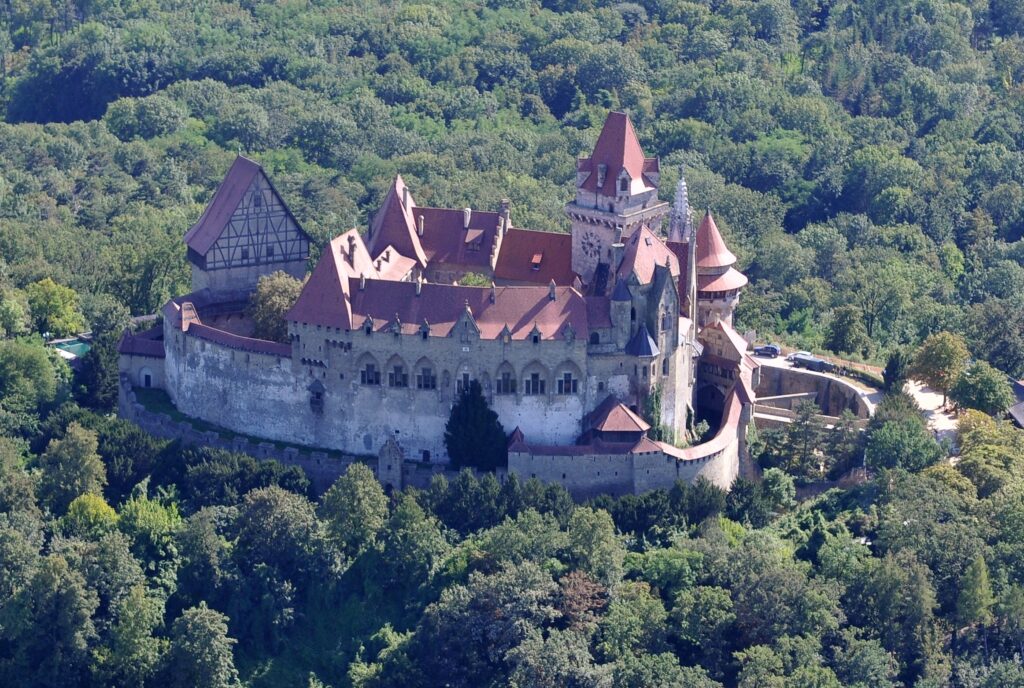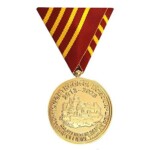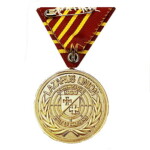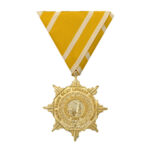Kreuzenstein Medal
In 2020 the International Lazarus Union and its Knighthood of Honour celebrated the 10th jubilee titular seat of the Lazarus Union – among others with a great Investiture Ceremony and other events. This anniversary was a good opportunity to celebrate and to visualize the changing of the General Plenipotentiary by the new “10 years Kreuzenstein Castle”-Medal.
The medal shows an image of Kreuzenstein Castle on the front and the newly adapted logo of the Lazarus Union on the reverse. The medal is worn on a red/gold striped ribbon. Diameter 42mm. For the design of the medal, we thank the founder of the Lazarus Union, Senator Prof.hon. Colonel Wolfgang Steinhardt PhD(USA) hon., who also shaped the newly adapted logo of the Lazarus Union. The jubilee medal can be ordered now via the Lazarus Union Web Shop. The net proceeds benefit the “EAC Project of the Lazarus Union”.
The Kreuzenstein Castle

Castle Kreuzenstein, located in Lower Austria near the town of Leobendorf, has a rich and varied history that reflects the broader historical developments in the region.
Early History and Construction
- Medieval Origins: The original Kreuzenstein Castle dates back to the 12th century, constructed by the Counts of Formbach. It served as a fortification and noble residence.
- Strategic Importance: Positioned on a hill overlooking the Danube River, the castle had significant strategic value for controlling trade routes and for defense.
Habsburg Acquisition and Decline
- Habsburg Ownership: In the late 13th century, the castle came under the ownership of the Habsburg dynasty, one of the most powerful royal houses in Europe.
- Turkish Wars: Kreuzenstein played a role during the Turkish wars in the 16th and 17th centuries. However, it suffered extensive damage during these conflicts, especially during the Thirty Years’ War (1618-1648).
Destruction and Ruin
- Thirty Years’ War: The castle was partially destroyed by Swedish troops in 1645, leaving it in a state of ruin for the next two centuries. The once formidable fortress became a picturesque ruin, attracting occasional visitors but no serious attempts at restoration.
Rebuilding in the 19th Century
- Count Johann Nepomuk Wilczek: In the late 19th century, Count Johann Nepomuk Wilczek, a wealthy nobleman and art collector, acquired the ruins. He embarked on an ambitious project to reconstruct the castle.
- Neo-Gothic Restoration: Between 1874 and 1906, Wilczek oversaw a comprehensive rebuilding of Kreuzenstein, transforming it into a neo-Gothic masterpiece. He incorporated medieval architectural elements from other castles and historical buildings, creating a historically inspired yet eclectic structure.
- Incorporation of Artifacts: The reconstruction involved integrating various art and architectural pieces from across Europe, including sculptures, furniture, and stained glass, enhancing the castle’s historical ambiance.
Modern Era
- Cultural and Tourist Attraction: Today, Kreuzenstein Castle serves as a museum and tourist attraction. It offers insights into medieval life and the architectural styles of different historical periods. Its picturesque setting and historical significance make it a popular destination for visitors.
- Film Location: The castle’s striking appearance has also made it a popular location for films and television, further enhancing its cultural footprint.
Kreuzenstein Castle’s history reflects a blend of medieval origins, periods of conflict and decline, and a remarkable revival in the 19th century. Its current state as a restored neo-Gothic castle serves as a testament to historical preservation and the enduring fascination with medieval architecture and history.






